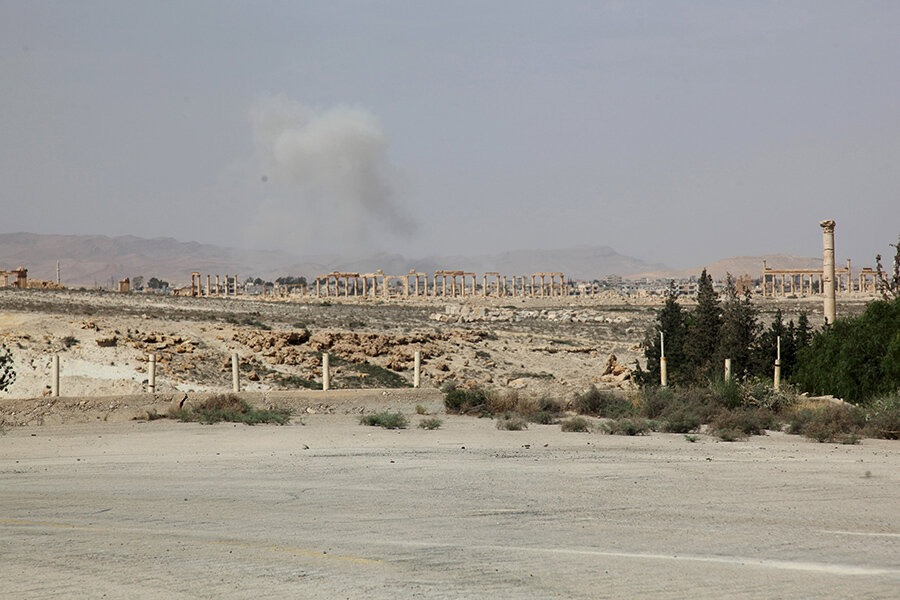Islamic State in control of Palmyra ruins, according to activists
Loading...
| Damascus, Syria
Islamic State militants overran the famed archaeological site at Palmyra early on Thursday, just hours after seizing the central Syrian town, activists and officials said, raising concerns the extremists might destroy some of the priceless ruins as they have done in neighboring Iraq.
The Islamic State's capture of the town of Palmyra late Wednesday was a stunning triumph for the militant group, only days after it captured the strategic city of Ramadi in Iraq's largest Sunni province.
As IS took Palmyra, government forces collapsed in the face of the attacks and Syrian soldiers were seen fleeing the area, activists said. In Damascus, state TV acknowledged that pro-government forces had withdrawn from the town.
Rami Abdurrahman of the Britain-based Syrian Observatory for Human Rights said the extremists overrun the archaeological site, just to the southwest of the town itself, shortly after midnight Wednesday.
An activist in Homs who goes by the name of Bebars al-Talawy also confirmed that IS now controls the ruins at Palmyra. Both activists said the militants had not damaged the site so far.
A Facebook page close to IS published a statement Thursday, purportedly from the group, saying "the soldiers of the Islamic State" completed their control of Palmyra as well as the town's airport and prison. The capture came after government forces collapsed, "leaving large numbers of dead whose bodies filled the streets," it said.
The ruins at Palmyra are one of the world's most renowned historic sites and there were fears the extremists would destroy them as they did major archaeological sites in Iraq. The UNESCO world heritage site is famous for its 2,000-year-old towering Roman-era colonnades and other ruins and priceless artifacts. Before the war, thousands of tourists a year visited the remote desert outpost, a cherished landmark referred to by Syrians as the "Bride of the Desert."
In Damascus, Maamoun Abdulkarim, the head of the Antiquities and Museum Department, said Palmyra's town museum had suffered "minor damages" during the IS onslaught.
"The city is now totally controlled by gunmen and its destiny is dark and dim," warned Abdulkarim. "We are in a state of anticipation and fear" about what will happen to "the archaeological site and the remaining artifacts in the museum."
Before the fall, hundreds of "the most precious and beautiful" pieces from Palmyra were taken to safe houses in Damascus, he added.
Also Thursday, many Palmyra residents were fleeing the town toward the city of Homs and the capital, Damascus, according to Talal Barazi, the governor of the central province of Homs, which includes Palmyra.
The Syrian army is now outside the town, from where it is targeting Islamic State reinforcements, he said.
"We have not received any news about (the archaeological site's) destruction," Barazi told The Associated Press. "We hope that there will be no massacres in the city or damage to the ruins."
Palmyra has a population of some 65,000 people, according to Barazi. He added that 1,300 residents fled over the past days and more were trying to leave on Thursday.
On Wednesday, the head of the UN's cultural agency called on Syria's warring factions to immediately end hostilities within the archaeological site.
"I am deeply concerned by the situation at the site of Palmyra. The fighting is putting at risk one of the most significant sites in the Middle East and its civilian population," UNESCO chief Irina Bokova said in a statement.
She urged all parties to respect international obligations to protect cultural heritage during conflict.
EU foreign policy chief Federica Mogherini said that following Palmyra's fall, thousands are at risk of arbitrary violent actions and more destruction of cultural sites might be perpetrated.
"Daesh's mass killings and deliberate destruction of archaeological and cultural heritage in Syria and Iraq amount to a war crime," she said, using an Arabic acronym to refer to IS.
Mogherini added that the EU has taken all the appropriate steps to prevent the illegal traffic of cultural artefacts that directly contributes to the financing of IS.
In taking Palmyra, IS also overran the town's notorious Tadmur prison, where thousands of Syrian dissidents have been imprisoned and tortured over the years.
An amateur video posted online showed IS fighters setting a giant poster of President Bashar Assad, allegedly inside the prison in Palmyra, cheering as flames rose around them against the night sky.
The video and its location could not be independently verified but appeared genuine and corresponded to other AP reporting of the events.
Al-Talawy, the Homs activist, said the government had recently transferred thousands of detainees from the Palmyra prison to a jail near Damascus.
But he added that IS extremists freed some of those who were still inside by the time they captured the prison. He could not provide any definitive figures but there were believed to have been thousands prisoners still there.
The Observatory said that with the capture of Palmyra and surrounding areas in recent weeks, IS now controls half of Syria — and most of the country's oil wells.
Palmyra's fall came at a deadly toll.
The Observatory said Thursday that according to its estimates, 462 people have been killed since IS began its offensive on Palmyra and nearby areas on May 13. It said the dead included 241 troops and pro-government gunmen, as well as 150 IS fighters. The rest were civilians, presumably killed by IS or in the crossfire.
Despite Islamic State's stunning victories in Palmyra and Iraq, the extremists suffered a setback in Syria's northeastern province of Hassakeh, where they have come under attack by Kurdish fighters.
The Kurdish fighters captured much of the Abdul-Aziz Mountain near the village of Tel Tamr on Wednesday, according to the Observatory and the Kurdish forces known as the People's Protection Units, or YPG.
The Observatory said YPG fighters were backed by airstrikes of the US-led coalition, which has been bombing IS positions in Syria since September.







